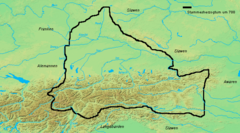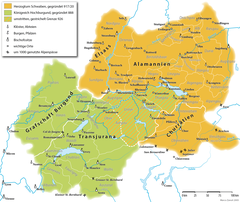Raetia secunda

Raetia secunda ( Vindelica ) or Vindelikien ( Vindelicien ) was a Roman province that emerged in the course of the Diocletian reforms in the early 4th century through the division of the former province of Raetia . It comprised the northern foothills of the Alps between the Iller , Danube and Inn , as well as a north-eastern part of today's Tyrol . Their capitals were Cambodunum ( Kempten ) and later Augusta Vindelicorum ( Augsburg ). The names Vindelica , Vindelicien , Vindelikien and Augusta Vindelicorum go back to the Celtic people of the Vindeliker , who lived here until the Roman campaign of 15 BC. Lived independently. The part of the name Raetia came from the southern neighboring people of the Raetians , against whom this campaign was initially waged. In the 5th and 6th centuries (a part of) Raetia secunda also became part of the Ostrogothic Empire , settled by Alamanni and east of the Lech the nucleus of the Germanic tribe of the Bavarians .
Predecessor province, Alamanni
The predecessor province of Raetia was established in the early 1st century AD to 15 BC. Chr. Conquered area established. Some of the subjugated peoples there were called Vindelici by the Romans , others as Raeti (cf. Raetians ). The province received its name from the councilors and its capital Augusta Vindelicorum from the Vindelicians . However, before Augusta Vindelicorum, Cambodunum was the capital of the province. In the second third of the third century, the raids by the Teutons from neighboring Germania Magna to the north into the province of Raetia increased dramatically. Due to a thinned out troop situation, the Romans could no longer sustainably push them back. A temporary connection to the Gallic Empire , which promised a resolute defense of the borders against the Teutons, only brought temporary success. The northern Limes border was withdrawn to the south to the Danube around 260 ( Limesfall ). The western border was withdrawn from the Black Forest to the east on the Iller . From Kempten ( Cambidanum ) the new border ran along the Argen , Lake Constance and the Upper Rhine ( Danube-Iller-Rhine-Limes ). Today's Upper Swabia and the Black Forest were gradually evacuated by the Romans. The province of Raetia shrank drastically. The land, never de jure, but at least de facto abandoned by the Romans, the Black Forest and Upper Swabia were settled from the west and from the north from the 4th century by Alemanni , who gradually spread to the east over the Iller and their settlement activity up to the Lech propelled.
Division of the previous province
As part of the Diocletian Empire reforms the province Raetia was 297 n. Chr. Along the Lake Constance and the northern Alps in two new provinces, Raetia prima ( Curiensis ) and Raetia secunda ( Vindelica ) split (with small shifts of borders with neighboring provinces). The two new provinces belonged to the Diocese of Italia and were militarily subordinate to a Dux Raetiae . In each of the two new provinces, civil administration was the responsibility of a praesides , governors of lower rank. The later German names “Churrätien” and “Vindelicien” were derived from their residences Curia Raetorum ( Chur ) and Augusta Vindelicorum ( Augsburg ).
The sparse sources only allow plausibility conclusions to be drawn regarding the exact dividing line. Until the 1930s, the prevailing opinion was that Raetia secunda had just encompassed the transalpine part (the Alpine foothills ) of the Raetia . The designation of Raetia II as " Vindelikien " u. suggests this, if it is assumed that the Vindelikers only lived in the foothills of the Alps and not in the Alps, cf. Droysen's card (and Raeter's article ).
Today, for example, in the New Pauly from 2001 you can find the information that the dividing line ran from Isny over the Arlberg through the Münstertal to the Stilfserjoch , or roughly along the current borders of Vorarlberg and Graubünden with Germany and Tyrol (North and South Tyrol). Heuberger (1930e, p. 358ff.) Argued that in the 6th century a bishop of Säben was also considered to be the bishop of the Raetia secunda , which was not separated from the previous Raetia I as the “new” Raetia II after the loss of the Alpine foothills (P. 364). He is based on later sources, original sources from the 6th century have not been preserved at all.
It is undisputed that the foothills of the Alps between the Iller, Danube and Inn (the part " Vindelikien s" that remained in Rome since the 3rd century ) belonged to the Raetia secunda (whose capital Augusta Vindelicorum was between Iller and Lech, and the Vita Sancti Severini explains that Künzing on the Danube and Batavis ( Castra Batava , Passau ) were places of the Raetia secunda ). It is less clear how far Raetia II reached into the Alps, and also how the area between the Iller, Argen and the mouth of the Alpine Rhine was divided. (Compare also Raetia: division of the province . )
Waning Roman control
In the 5th century, Roman control over the foothills of the Alps waned, the border forts of Raetia II on the Danube were gradually abandoned, according to the Vita Sancti Severini , most recently against 470 Quintanis ( Künzing ) and Batavis ( Castra Batava , Passau ) under the impression more permanent Alamannen -Überfälle (along the Donau). When the Ostrogothic king Theodoric the Great took over the leadership of West Rome, he tried to re-establish the former province of Raetia as a bulwark. a. by accepting Alamanni oppressed by the Franks . It is not clear how far he regained control of the Alpine foothills.
Alamannen am Lech, Bavaria, final disintegration

South of the Danube, the Alemanni extended their settlement area by around 500 across the Iller to the Lech . In the following time, the Germanic tribe of the Bajuwars ( Baiern ) formed east of the Lech from Alamanni, other Germanic immigrants, remaining Vindelikers and Roman civilians . According to Thomas Fischer , this ethnogenesis was controlled by Theodoric to strengthen the northern border of his empire .
At least since the defeat of the Ostrogoth Empire by the Eastern Roman Emperor Justinian I around 540, there was no longer any significant reference between the earlier transalpine Raetia , the actual “ Vindelikien ”, to the Roman Empire. In contrast, in the southern sister province of Raetia , administered from Chur ( Curia Raetorum ), the terms Churrätien , Rätien and Rätisch u. in use in Switzerland ( Graubünden ) from the Middle Ages to modern times, especially for the community of the Three Leagues and for institutions in modern Graubünden .

The emergence and subsequent expansion of the Bavarian wars also affected the eastern neighboring province of Noricum and finally the (presumably located south of it) alpine part of the Raetia secunda . The Bavarians populated old Bavaria ( Raetia II east of the Lech) and Austria , in the Tyrolean Alps . They later formed the Duchy of Bavaria .

To the west of the Lech , regardless of the provincial borders, the Alamanni oriented themselves towards their relatives around the Upper Rhine and Lake Constance , where they formed an autonomous duchy of Alamannia in the Frankish Empire until 746 .
Aftermath: Bavarian Swabia
In the 19th century, the Kingdom of Bavaria came into the possession of part of Swabia , called Bavarian Swabia , located between Iller and Lech and stretching from the Allgäu Alps (like Raetia once ) across the Danube into the Donau-Ries district . As the administrative district of Swabia , this area is now subject to the Free State of Bavaria . As the “irony of history”, the two peoples of the Alemanni and the Bavarians , who had diverged in Vindelikien, were locally dependent on each other again. In a certain way, the advance of the Alamanni from the Iller to the Lech during the Migration Period was "corrected" by this political development 1300 years later.
See also
Further details, larger contexts and references can be found in the articles
literature
- Richard Heuberger : Raetia prima and Raetia secunda. In: Klio. Contributions to ancient history. Vol. 24 (New Series Volume VI), 1931, pp. 348–366 ( PDF; 1.54 MB ).
Web links
- Article Vindelicien ( page facsimile ) in Meyers Großem Konversations-Lexikon , Volume 20. Leipzig 1909, p. 175.
Individual evidence
- ^ Heuberger (1930e). In contrast to p. 350 there, Heuberger already represented in the addendum on p. 366 and in his subsequent publications the view prevailing today that the Vinschgau had belonged to Raetia II . In Rätien , pp. 301ff., Heuberger supplements his earlier argument.
- ↑ Col. 753 of: Gerhard H. Waldburg: Raeti, Raetia. In: The New Pauly (DNP). Volume 10, Metzler, Stuttgart 2001, ISBN 3-476-01480-0 , Sp. 749-754.
- ↑ See Heuberger (1930e) , pp. 356 and 351 ("Brenner area"), Raetia II here consists of "Vindelikien" and the "Brenner area".
- ↑ See Heuberger (1930e) , p. 348f.
- ↑ Heuberger, Rätien , p. 122f.
- ↑ p. 410f. by: Thomas Fischer: From the Romans to the Bavarians. The Alpine foothills in the 5th century. In: Wolfgang Czycz, Karlheinz Dietz, Thomas Fischer, Hans-Jörg Kellner: The Romans in Bavaria. Theiss, Stuttgart 1995, pp. 405-411.

